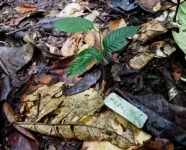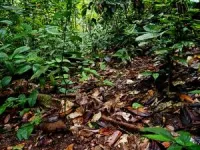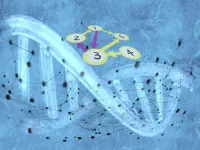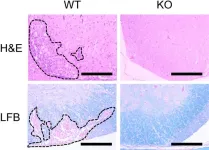(Press-News.org) Rainforest seedlings are more likely to survive in natural forests than in places where logging has happened – even if tree restoration projects have taken place, new research shows.
Scientists monitored over 5,000 seedlings for a year and a half in North Borneo.
They studied a landscape containing both natural forest and areas logged 30 years ago – some of which were recovering naturally, while some had been restored by methods including tree planting.
A drought had triggered “mast fruiting” across the region, with trees simultaneously dropping fruit en masse and new seedlings emerging.
At first, both natural forest and restored forest had similarly high numbers of seedlings, compared to naturally recovering forest – suggesting restoration activities enhanced fruit production.
But these benefits did not last: low seedling survival in the restored forest meant that, by the end of the study, similarly low numbers of seedlings remained in restored and naturally recovering forest. Seedling populations remained higher in natural forest.
Together, these results show that regeneration may be challenged by different factors depending on the restoration approach – seed availability in naturally recovering sites and seedling survival in sites where planted trees have matured. These differences may have longer-term implications for how forests can deliver key ecosystem services such as carbon sequestration.
Dr Robin Hayward, who undertook this research during their PhD at the University of Stirling, said: “We were surprised to see restoration sites having lower seedling survival. After such a productive fruiting event in the restored forest, it’s disappointing that so few were able to survive – and to think what this might mean for the long-term recovery of different tree species.”
Whilst restoration has been shown to benefit biomass accumulation (the total amount of growth) in these forests, the research indicates this is not yet enabling full establishment of the next generation of seedlings.
Dr David Bartholomew, based at the University of Exeter during the study and now at Botanic Gardens Conservation International, said: “Our findings suggest that seedlings are experiencing stress in logged forests. This could be due to changes to the canopy structure, microclimate and soil, with current restoration treatments insufficient to eliminate this stress. In particular, highly specialised species seem to struggle to survive, leaving communities with reduced species diversity compared to intact forest.”
Daisy Dent of ETH Zürich, Switzerland and the Smithsonian Tropical Research Institute, Panama said: “Rainforests are complex systems and there are many possible explanations for our results. For example, animals that eat seeds – like bearded pigs – may be drawn into restored forest patches to eat the more abundant seeds and seedlings, rather than moving into adjacent poor-quality logged forest. In natural forests, animals potentially move more freely and so do not exhaust seed supplies in the same way.”
Selective logging of forests is prevalent throughout the tropics, and long-term recovery is crucial to maintaining carbon stocks and high biodiversity. Low rates of survival among seedlings three decades after logging therefore raise concerns about potential regeneration failure in future generations of trees.
Dr Lindsay F Banin of the UK Centre for Ecology & Hydrology, said: “Together, these results reveal there may be bottlenecks in recovery of particular elements of the plant community. We are now progressing this research into the various stages of the regeneration process – fruiting, germination, establishment and causes of mortality – to help understand which mechanisms are driving the patterns we have observed and how we can better assist forest regeneration and support the long-term sustainability of degraded forests.”
The study highlights the importance of carefully designing, monitoring and adaptively managing restoration projects so that they can recover both biodiversity and carbon in biomass over the long-term. This is key to restoring degraded landscapes and achieving global targets such as those outlined in the UN Kunming-Montreal Global Biodiversity Framework and the UN Decade on Ecosystem Restoration.
Local environmental conditions may differ between restored areas with higher biomass and canopy cover than in degraded areas with no restoration. Plant traits, or characteristics that determine how plants function, may be the key to understanding the low survival rates of seedlings – they can reveal which resources the plants are struggling to access.
The study observed differences in traits of the plants in logged areas compared to intact forest, showing that some species may be struggling to survive in disturbed areas, and some have to adapt how they grow to accommodate. This could lead to differences in biodiversity and ecological functioning in the long-term.
This study captures just 18 months after one fruiting event. Longer-term research is required to understand the full effects of historic disturbance, and how to enhance seedling survival.
The study was conducted in the Danum Valley Conservation Area and the surrounding Ulu Segama landscape of North Borneo.
Here, intact forests are dominated by a tree family, the Dipterocarpaceae, which along with many other tree families, fruits in large inter-annual episodes known as masting events.
These cyclical events have important cascading effects on food availability for animal species.
The study, published in the journal Global Change Biology, is entitled: “Bornean tropical forests recovering from logging at risk of regeneration failure Running Title: Seedling responses to logging and restoration.”
END
Rainforest's next generation of trees threatened 30 years after logging
2024-03-12
ELSE PRESS RELEASES FROM THIS DATE:
Expertly engineered saccharomyces cerevisiae yeast strain in the optimized production of carotenoids
2024-03-12
More than 90% of the commercially available carotenoids are synthetically produced using chemicals. To meet the increasing demand for cost-effective natural compounds in carotenoid synthesis, researchers at Xiamen University, China, have developed an engineered S. cerevisiae yeast strain capable of selectively overproducing carotenoids. They redesigned the genomic sequence and critical pathways to optimize carotenoid production. This novel and successful research approach can be extended to other model ...
Beer byproduct behind Marmite could help us recycle metal waste
2024-03-12
When we recycle electronic devices we can no longer use, we expect to make the most out of the precious natural resources that went into building them. But electronic waste is notoriously difficult to recycle, because it’s hard to separate the different metals in the waste from each other. Scientists have now found a way of selectively capturing metals from a waste stream using spent brewer’s yeast, the same beer byproduct that goes into Marmite. Not only that: the yeast can be reused, making the process even more eco-friendly.
“Electronic waste is difficult to recycle because it is very heterogeneous,” said Dr Klemens Kremser ...
Guessing game: Response may bias understanding of future scenarios
2024-03-12
Does previous experience bias a person in future estimations? Yes, Osaka Metropolitan University researchers in Japan report, but only if the person engages higher processing powers by responding, as opposed to simply observing.
They made their findings through experiments involving participants estimating the number of dots flashed on a screen. Participants either had to input their estimate before making another estimate on a new set of dots or were not prompted to do anything but observe. The researchers found ...
KKH-led study reveals low COVID-19 transmission rate from mothers to newborns
2024-03-12
11 March 2024, Singapore – A study[1] by KK Women’s and Children’s Hospital (KKH), Singapore General Hospital (SGH) and National University Hospital (NUH) has revealed that COVID-19 transmission from mothers to their newborns is low.
The study involving 371 women who had COVID-19 infection during pregnancy and their newborns found that only four infants or 1.1 per cent of the babies were diagnosed with COVID-19 after birth, of which three (1.1 per cent) were from mothers who were COVID-19 vaccinated and one infant (1.3 per cent) was from a mother who was not vaccinated.
Senior Author of the study, Dr Yeo Kee Thai, Senior Consultant, Department of Neonatology, KKH ...
Scientists identify biodiversity conservation gaps in Madagascar
2024-03-12
Despite the importance of biodiversity and the urgency to conserve it, assessing what aspect of biodiversity requires the highest priority has proven complex, especially when conservation resources are limited. A new study published in Current Biology sheds light on this question.
Prof. CHEN Zhiduan's team from the Institute of Botany of the Chinese Academy of Sciences (IBCAS) and international collaborators have identified the spatial heterogeneity of biodiversity hotspots and endemism centers. With ...
Sting operation out of gas
2024-03-12
Kyoto, Japan -- Cells possess an innate immune system that defends against invasive pathogens such as bacteria and viruses. Previous studies have mapped out the cytoplasmic cGAS-STING pathway in the cytoplasm, known for responding to foreign nucleic acids, such as double-stranded DNA.
Micronuclei -- or MN, abnormal intracellular structures containing the cell's DNA -- have also been suspected of triggering the pathway. However, no conclusive evidence exists of pathway activation by MN-induced cyclic GMP-AMP synthase, or cGAS.
Now, Kyoto University and the AIRC Institute of Molecular Oncology, or IFOM, have ...
Have metalenses expanded their reach into the ultraviolet region?
2024-03-12
Ultraviolet rays find diverse applications in medical and healthcare, serving purposes such as disinfection, sterilization, and therapy. They are also used in the semiconductor industry for creating microcircuits and patterns. A metalens fabrication process, developed by a team of researchers at Pohang University of Science and Technology (POSTECH), enables control over the optical properties of these UV rays. This innovation has garnered significant attention across industries, sparking interest in potential advancements.
A collaborative research team, comprising Professor Junsuk Rho from the Department of Mechanical Engineering and the Department of Chemical Engineering ...
Key protein linked to immune disorders
2024-03-12
A new study highlights a potential therapeutic target for immune-related disorders, such as multiple sclerosis and asthma.
A new study has shed light on the importance of the protein STAP-1 in activating certain immune cells. Understanding the role of STAP-1 in these cells could give researchers a better glimpse into immune-related disorders and ways to treat them.
The researchers found that STAP-1 plays an important role in the activation of T cells, which are white blood cells that play a critical role in defending the body against infections and maintaining overall health. T cells are adept at recognizing foreign molecules that ...
COVID-19 had greater impact on life expectancy than previously known, but child mortality rates continued to decline during the pandemic
2024-03-12
**Embargo: 23:30 UK, 7:30 p.m. ET March 11, 2024**
***Please note the unusual embargo time for the United States due to daylight savings time***
Global Burden of Disease
COVID-19 had greater impact on life expectancy than previously known,
but child mortality rates continued to decline during the pandemic
A new study published in The Lancet reveals never-before-seen details about staggeringly high mortality from the COVID-19 pandemic within and across countries. Places such as Mexico City, Peru, and Bolivia had some of the largest drops in life expectancy from 2019 to 2021. The research, which presents updated ...
NSF CAREER Grant awarded to Dr. Jordon Gilmore Associate Professor of Bioengineering Clemson University
2024-03-12
Congratulations to Dr. Jordon Gilmore for receiving the prestigious NSF CAREER Award! The project is titled: "A Multi-phase Biosensing Approach towards Point-of-Care Evaluation of Pseudomonas aeruginosa Virulence in Infected Chronic Wounds". The project is in perfect alignment with the ADAPT in SC NSF Award. Dr. Gilmore is a co-leader of the the Explainable AI-Enabled Biomedical Devices for Diagnostics and Planning Applications, and the leader of the Broadening Participation and Diversity project areas of ADAPT in SC. In addition, he serves as a member of the ...










